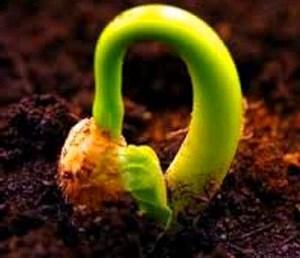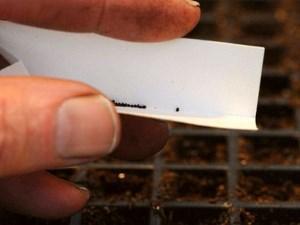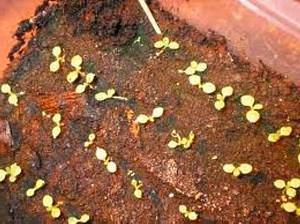Growing begonias from seeds
 Growing begonias by seeds is a rather troublesome business, requiring constant, vigilant strict control, but if all the basic nuances of agricultural technology are observed, the results will surely please you.
Growing begonias by seeds is a rather troublesome business, requiring constant, vigilant strict control, but if all the basic nuances of agricultural technology are observed, the results will surely please you.
Most often grown from seeds ever flowering and decorative leafy types of begoniasbut tuberous begonias can also be obtained from seeds, although it is worth noting that this process is not quick, so you need to be patient.
The most successful period for growing begonias by seeds is the end of February - the first ten days of March, when daylight hours begin to grow rapidly, the activity of the sun increases and it will be much easier to maintain the required temperature regime.
How to grow begonia from seeds?
 First of all, before you start sowing begonias with seeds, you should choose high-quality and convenient seed for you. In specialized stores, florists and gardeners can be offered two types of seeds: granular and ordinary, unprocessed.
First of all, before you start sowing begonias with seeds, you should choose high-quality and convenient seed for you. In specialized stores, florists and gardeners can be offered two types of seeds: granular and ordinary, unprocessed.
Pelleted (granulated) seeds are easier to sow because, thanks to a special coating of nutrients, they become larger and are great for spot sowing in peat tablets
Before planting begonias with seeds in peat tablets, the tablets themselves should be placed on a pallet, well soaked in water, then placed on the surface of each of them granular seed, moisten it with water at room temperature (it is best to use a spray bottle) and cover with a plastic bag or disposable plastic bag glass to maintain the required moisture level. Watering a tablet with sown seeds is done through a pallet, its moisture must be monitored very carefully, otherwise only the sprout that has formed will simply dry out.
 If the temperature regime is 22 - 23 ° C, the first shoots will begin to appear after 14 days, then, after the formation of the third true leaf, the tablets with seedlings are planted in individual seedling pots, completely filling the peat mass with soil and thoroughly spilling the top layer with water at room temperature.
If the temperature regime is 22 - 23 ° C, the first shoots will begin to appear after 14 days, then, after the formation of the third true leaf, the tablets with seedlings are planted in individual seedling pots, completely filling the peat mass with soil and thoroughly spilling the top layer with water at room temperature.
Sowing begonias with ordinary seeds, not covered with a shell, is most conveniently done in seedling boxes. For sowing, it is best to choose a light, loose soil mixture with a large amount of peat in its composition, the main condition for the healthy development of begonia seedlings is the absence of stagnant water and good aeration, so you should take care of the correct drainage arrangement.
An important nuance in the question of how to plant begonia with seeds is the correct sowing technique: the seeds are located on a moistened surface, well spilled with water from a spray bottle, after which the boxes with crops are covered with plastic wrap or glass. This is necessary in order to maintain the moisture level necessary for seed germination.
Watering must be done very carefully, make sure that the soil is moist, but no water stagnation is created, which can lead to the development of fungal microflora that affects the weak delicate thin roots of the seedlings.
The boxes should be placed in a room with good lighting, but at the same time protected from aggressive direct sunlight, which can only burn out the emerging shoots, which should be expected 10 - 12 days after sowing, at a content temperature of 21 - 22 ° C.
 Gradually, it is necessary to start hardening the seedlings, for which the film is slightly opened and the boxes with seedlings are left in this position for 10 - 15 minutes. Then the airing (hardening) time and the degree of film opening increase, gradually accustoming the seedlings to the usual environment.
Gradually, it is necessary to start hardening the seedlings, for which the film is slightly opened and the boxes with seedlings are left in this position for 10 - 15 minutes. Then the airing (hardening) time and the degree of film opening increase, gradually accustoming the seedlings to the usual environment.
This technique also allows you to avoid the development of fungal microorganisms on the surface of the soil, which can occur on constantly moist soils if the temperature regime is not observed or with improper, excessive watering.
After the appearance of the third true leaf, the seedlings need to be picked into separate seedling pots. This process is quite laborious, requiring a lot of time, effort, patience and accuracy.
Plants are transplanted one at a time into a container filled with a light, crumbly loose soil composition, spilled and set in a well-lit place, while the temperature gradually decreases to 20 ° C.
How to plant tuberous begonia seeds
If you are wondering how to grow begonia from seeds, if it belongs to the tuberous species, then the answer to this question is very short.
The agrotechnology of growing begonias with tuberous seeds has a number of nuances:
- The temperature of the content of crops should be 22 - 27 ° C;
- After emergence, the temperature is gradually reduced to 19 ° C;
- After the formation of the third leaf, the seedlings dive;
- The second pick is carried out 4 - 5 weeks after the first.
It is worth noting that the formation of a tuber when growing begonias from seeds takes quite a long time, so if you sowed in early March, you will be able to get a fully formed tuber only by the beginning of next winter.
Of course, growing begonias from seeds is quite a painstaking task, but at the same time it is very exciting and rewarding. If you take care of your green babies, provide them with excellent care, devote your time to them, protect them from stress and unfavorable conditions, then the flowers will greatly thank you in the summer with spectacular, bright, crazy and long flowering, bright healthy foliage and a beautifully formed bush.